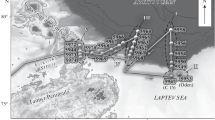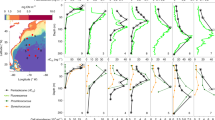Abstract
C2-C6 Nonmethane hydrocarbon (NMHC) concentrations in the atmospheric boundary layer and in surface seawater were simultaneously measured during an oceanographic cruise in the intertropical Indian Ocean. NMHC were found to be mainly C2-C4 alkenes and C2-C3 alkanes. Their concentrations ranged from 1 to 30×10−9 l/l in the seawater and 0.1 to 15 ppbv in the atmosphere. Seawater appeared to be a source because the C2-C6 NMHC were supersaturated with respect to the atmosphere by 2 or 3 orders of magnitude.
After a selection of the pure marine atmospheric samples, performed with the help of stable and radioactive continental tracers, we found an identical composition in NMHC of surface air and seawater. This observation enabled us to establish that the gas transfer between sea and air occurred according to nonsteady state processes, and that the fluxes cannot be deduced only from atmospheric measurements. An order of magnitude value of the oceanic source for the different NMHC is however derived from the comparison of their sea water concentrations to that of propane and an independent evluation of the marine source of this last compound.
Similar content being viewed by others
References
Atkinson, R., Darnall, K. R., Lloyd, A. C., Winer, A. M., and PittsJr., J. N., 1979, Kinetics and mechanisms of the reactions of the hydroxyl radical with organic compounds in the gas phase, Adv. Photochem. 11, 375–488.
Blake, D. R. and Rowland, F. S., 1986, Global atmospheric concentrations and sources strength of ethane, Nature 321, 231–233.
Bonsang, B. and Lambert, G., 1985, Nonmethane hydrocarbons in an oceanic atmosphere, J. Atmos. Chem. 2, 257–271.
Brooks, J. E. and Sackett, W. M., 1973, Sources, sinks, and concentrations of light hydrocarbons in the Gulf of Mexico, J. Geophys. Res. 78, 5248–5258.
Brooks, J. E., Kennicutt, M. C., Fay, R. R., McDonald, T. J., and Sassen, R., 1984, Thermogenic gas hydrates in the Gulf of Mexico, Science 225, 409–411.
Ehhalt, D. H. and Rudolph, J., 1984, On the importance of light hydrocarbons in multiphase atmospheric systems, Berichte der Kernforschungsanlage Julich-No. 1942, Institut für Chemie 3, Atmospharische Chemie (eds.), 1–43.
Gaudry, A., Ascencio, J. M., and Lambert, G., 1983, Preliminary study of CO2 variations at Amsterdam Island (Territoire des Terres Australes et Antarctiques Françaises), J. Geophys. Res. 88, 1323–1329.
Greenberg, J. P. and Zimmerman, P. R., 1984. Nonmethane hydrocarbons in remote tropical, continental and marine atmospheres, J. Geophys. Res. 89, 4767–4778.
Heimann, M., Keeling, C. D., and Mook, W. G., 1985, A three-dimensional model of atmospheric CO2 transport based on observed winds. 1. Observational data and model, Proceeding of the IAMAP/CACGP Conference on Atmospheric Carbon Dioxide, Kandersteg, 2–6 Sept. 1985.
Hoang, C. T. and Servant, J., 1972, Le flux de radon de la mer, C.R. Acad. Sci. Paris. 274, Serie D, 3157–3160.
Komhyr, W. D., Waterman, L. S., and Taylor, W. R., 1983, Semiautomatic nondispersive infrared analyser apparatus for CO2 air sample analyses, J. Geophys. Res. 88, 1315–1322.
Komhyr, W. D., Gammon, R. H., Harris, T. B., Waterman, L. S., Conway, T. J., Taylor, W. R., and Thoning, K. H., 1985, Global atmospheric CO2 distribution and variations from 1968–1983 NOAA/GMCC CO2 flask sample data, J. Geophys. Res.. 90, 5567–5596.
Lambert, G., Polian, G., and Taupin, D., 1970, Existence of periodicity in radon concentrations and in large scale circulation at lower altitudes between 40 and 70° S, J. Geophys. Res. 75, 2341–2345.
Lambert, G., Ardouin, B., Polian, G., and Sanak, J., 1972, Conf. 720805, The Natural Radiation Environment II, Proc. Second Int. Symp. on the Natural Radiation Environment. Aug. 7–11, 1972 Houston (Texas) U.S.A. USAEC Health and Safety Laboratory, 787–807.
Lamontagne, R. A., Swinnerton, J. W., and Linnenbom, W. J., 1973, C1-C4 hydrocarbons in the North and South Pacific, Tellus 26, 71–77.
Liss, P. S., 1983, Gas transfer: experiment and geochemical implications, in P. S., Liss and W. G., Slinn, (eds.), Air-Sea Exchange of Gases and Particles, D. Reidel, Dordreeht, pp. 241–298.
McAuliffe, C., 1966, Solubility of paraffin, cycloparaffin, olefin, acetylene, cycloolefin, and aromatic hydrocarbons, J. Phys. Chem., 70, 1267–1275.
Polian, G., Lambert, G., Ardouin, B., and Jegou, A., 1986, Long range transport of continental radon in subantarctic and antarctic areas, Tellus 38B, 178–189.
Rudolph, J. and Ehhalt, D. H., 1981, Measurements of C2-C5 hydrocarbons over the North Atiantic, J. Geophys. Res. 86, 11959–11964.
Rasmussen, R. A., and Khalil, M. A. K., 1982, Latitudinal distributions of trace gases in and above the boundary layer, Chemosphere, 11, 227–235.
Singh, H. B. and Salas, L. J., 1982, Measurement of selected light hydrocarbons over the Pacific Ocean: latitudinal and seasonal variations, Geophys. Res. Lett. 8, 842–845.
Swinnerton, J. W. and Linnenbom, V. J., 1967, Gaseous hydrocarbons in sea water: determination, Science 156, 1119–1120.
Wilson, D. F., Swinnerton, J. W., and Lamontagne, R. A., 1970, Production of carbon monoxide and gaseous hydrocarbons in seawater: relation to dissolved organic carbon, Science 168, 1577–1579.
Author information
Authors and Affiliations
Rights and permissions
About this article
Cite this article
Bonsang, B., Kanakidou, M., Lambert, G. et al. The marine source of C2-C6 aliphatic hydrocarbons. J Atmos Chem 6, 3–20 (1988). https://doi.org/10.1007/BF00048328
Received:
Revised:
Issue Date:
DOI: https://doi.org/10.1007/BF00048328




